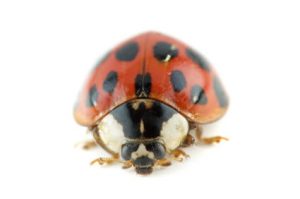What is making your arborvitae brown? Bagworm is the likely culprit. Bagworm is the second greatest cause of damage to arborvitae in Massachusetts, outdone only by deer. The bagworm larva starts feeding in June, when it can go unnoticed. Insecticide spraying must be done in June before the larva is too large. This larval stage builds a structure made of arborvitae tissue held together with silk. The silken house camouflages and protects the larva. It is hidden from view and also protected from insecticides.
Bagworm damage can appear rapidly, even though they may have been feeding for months, the damage final reaches a critical mass. In July or August the damage appears overnight. Remove, kill and discard of the nuisance pest., best way place in a pail of soapy water, then a sealed plastic trashbag left on a hot surface. Call for a free inspection if you suspect bagworm on your arborvitae.
Bagworm pulling his house at end shown next to pupa casings.
No need to panic if you see a roach in your home. Wood roaches look a lot like German cockroaches. Wood roaches do not have the two dark marks on the thorax (section of the body after the head) that distinguish German cockroaches. In eastern Massachusetts, wood roaches are very active in June. If you are in your yard or garden, especially in the late afternoon, you will see many wood roaches. These roaches do not infest structures. Wood roaches are attracted by light. They enter around screen doors and window screens at dusk or the early evening. The Boll's wood cockroach pictured below is the light tan color of a German roach, but without the 2 dark marks on the thorax.
If you find cockroaches in areas of your home without heavy humidity in June, it is likely a wood cockroach and pest control service or treatment is not necessary. First, vacuum or pick and remove the roaches that are inside. Then use blinds or shades to reduce light emission from the inside of your home. Finally, judiciously use exterior lights to minimize wood roach activity around doors.
This cool spring has warmed up with termite swarmers virtually every day. Termites eat wood from the inside out - so swarming termites may be the only warning a homeowner gets about termites eating inside the home. Other signs of termites include termite mud tubes. Termites construct these tubes you can see in this photo to keep humidity in the tunnels at 100%. Termites carry dirt from underground and bring it up into the food (like your home).
To Our Customers,
A lot has changed over the last week. One thing that has not changed is our commitment to our customers. Governor Baker has ordered all non-essential businesses to close, effective March 24, 2020. The pest control industry is considered an essential service.
Please be assured we will continue to service our customers with modifications. Inspections, applications of registered pesticides and tick service applications will proceed with those modifications.
If you have any questions, please feel free to contact our office at 617-964-4733. We are available weekdays between 7:00 am and 5:30 pm and Saturdays between 8:00 am and noon.
Finally, our hearts go out to all those affected by the Covid-19. We all navigate this evolving situation together. Thank you for being a customer and thank you for your continued support. Stay healthy.
The Greenhow Team
What is causing the yellow and brown spots in my lawn? It is unusual in eastern Massachusetts to see turf injury in November. My initial reaction was a fungal disease. Looking at the margins of the injured areas the blades show symptoms similar to a disease, but without any characteristics to identify the disease.
This is the result of Chilling Injury. The symptoms show up on areas where it is sunny in the afternoon and has excellent air movement. It showed up all over Concord, Sudbury and Framingham over the past week. Reports came in beginning on Wednesday, Nov 4th and getting worse each day. Similar to winter burn in ornamentals, the cause is rapid dessication due to excessive transpiration. It is a rare injury to have here in New England. Chilling Injury is a condition I have never seen or heard of it before. I would still be trying to identify the disease if I had not received the update from UMASS detailing Chilling Injury</a>. The contributing factors are sudden onset of cold temperatures, dry air and dry wind, plus lots of sun.





